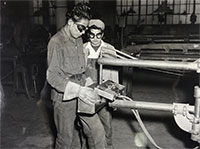Working in Duluth
The western end of Lake Superior has been providing opportunities for Native people to make a living for hundreds of years, from long ago to the present day. Long before Europeans came, the area around Duluth and the Duluth-Superior harbor was a rich source of resources sustaining the way of life of Native people who lived there. The harbor, the St. Louis River, and Lake Superior supplied fish throughout the year. Inlets in the harbor and inland lakes provided wild rice. Maple groves gave residents a yearly supply of maple sugar and many other plant resources for living and for medicine were available in abundance. In addition to supplying villages pre-dating the city of Duluth, these resources drew Native people from other nearby communities.
Sieur Dulhut's purpose in coming to the area of the present city of Duluth in 1679 was to draw together tribal representatives from all over the region to meet and make peace. In the centuries since Sieur Dulhut's arrival and departure, Indigenous people from all over America have come to the city to live and work. At the time of Sieur Dulhut's arrival the main local residents in the area were Dakota. In modern times Ojibwe people have been the predominant Indigenous residents of Duluth. The proximity of the Fond du Lac, Bois Forte, Red Cliff, and Bad River reservations, and many others, have drawn many people to come to Duluth to work and to be with relatives who were already there.
By the late 19th century Duluth, with its growing businesses, became a place to go when jobs were scarce near to and on the reservation. In an oral history interview recorded in the 1980s, Fond du Lac tribal member Elizabeth Sullivan Danielson--whose parents were Mike Sullivan and Mary Beargrease--recalled that she was not present on the reservation at the time of the Cloquet Fire that devastated the region of the reservation in 1918. Instead she was in Duluth working for the Marshall Wells Hardware Company as a typist. She had had the job for three months at the time of the fire:
At the time of the fire I went home. We heard that everybody was burned to death in Cloquet and that day I went to Cloquet the next day. The train was running alright but my folks they had saved their house. But that's the last time I worked there because my mother then had the flu and I had to stay home and take care of her. But then I went back to Duluth and I done other work.
When Mary Sullivan returned to Duluth she got work at the Nopeming Sanitarium.
World War II brought many people from reservations throughout the Midwest to Duluth to help with the war effort. One Mille Lacs band member recalled in 2015 that her father went to Duluth to work as a welder in the shipyards during the war, returning to Mille Lacs only after he was injured on the job.
Many Native people who have come to Duluth have kept ties to their home communities and have returned regularly for visits with family. A woman from Bois Forte interviewed in 2015 recalled that she and her husband came to Duluth after World War II so that her husband could get a job. They lived in temporary housing in a Quonset hut on the east end of Duluth, and then, when they were able, started construction on a house. At that time family members from Bois Forte came to the city to help with the construction.
Associated Images
click for larger image with caption
Copyright © 2022. All rights reserved.



